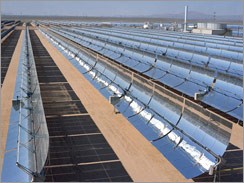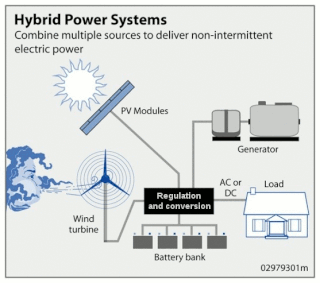
Solar power in Australia is a fast growing industry. As of June 2019, Australia's over 2.15 million solar PV installations had a combined capacity of 12,959 MW photovoltaic (PV) solar power, of which 3,819 MW were installed in the preceding 12 months. In 2019, 59 solar PV projects with a combined capacity of 2,881 MW were either under construction, constructed or due to start construction having reached financial closure. Solar accounted for 5.2% of Australia's total electrical energy production in 2018.
Ministry of New and Renewable Energy or MNRE is a ministry of the Government of India. The ministry is currently headed by R. K. Singh, a Minister of State. The current secretary of the ministry is Anand Kumar. The ministry was established as the Ministry of Non-Conventional Energy Sources in 1992. It adopted its current name in October 2006.

According to preliminary data from the US Energy Information Administration, renewable energy accounted for about 11% of total primary energy consumption and about 17% of the domestically produced electricity in the United States in 2018. Hydroelectric power is currently the largest producer of renewable electricity in the country, generating around 6.5% of the nation's total electricity in 2016 as well as 45.71% of the total renewable electricity generation. The United States is the fourth largest producer of hydroelectricity in the world after China, Canada and Brazil.
A feed-in tariff is a policy mechanism designed to accelerate investment in renewable energy technologies. It achieves this by offering long-term contracts to renewable energy producers, typically based on the cost of generation of each technology. Rather than pay an equal amount for energy, however generated, technologies such as wind power and solar PV, for instance, are awarded a lower per-kWh price, while technologies such as tidal power are offered a higher price, reflecting costs that are higher at the moment and allowing a government to encourage development of one technology over another.

Solar power is the conversion of energy from sunlight into electricity, either directly using photovoltaics (PV), indirectly using concentrated solar power, or a combination. Concentrated solar power systems use lenses or mirrors and tracking systems to focus a large area of sunlight into a small beam. Photovoltaic cells convert light into an electric current using the photovoltaic effect.
DESERTEC was a large-scale project supported by a foundation of the same name and the consortium Dii created in Germany as a limited liability company (GmbH). The project aimed at creating a global renewable energy plan based on the concept of harnessing sustainable power from sites where renewable sources of energy are more abundant and transferring it through high-voltage direct current transmission to consumption centers. All kinds of renewable energy sources are envisioned, but the sun-rich deserts of the world play a special role.

Historically, the main applications of solar energy technologies in Canada have been non-electric active solar system applications for space heating, water heating and drying crops and lumber. In 2001, there were more than 12,000 residential solar water heating systems and 300 commercial/ industrial solar hot water systems in use. These systems presently comprise a small fraction of Canada’s energy use, but some government studies suggest they could make up as much as five per cent of the country’s energy needs by the year 2025.
Martin Next Generation Solar Energy Center is the solar parabolic-trough component of an integrated solar combined cycle 1150 MW plant, in western Martin County, Florida, United States, just north of Indiantown. The project was built by Florida Power & Light Company (FPL). Lauren Engineers & Constructors (Abilene, TX) was the EPC contractor for the project. It's construction began in 2008 and was completed by the end of 2010.

Solar power in California includes utility-scale solar power plants as well as local distributed generation, mostly from rooftop photovoltaics. It has been growing rapidly because of high insolation, community support, declining solar costs, and a Renewable Portfolio Standard which requires that 33% of California's electricity come from renewable resources by 2020, and 50% by 2030. Much of this is expected to come from solar power via photovoltaic facilities or concentrated solar power facilities.

Turkey is located in an advantageous position in the Middle East and Southeast Europe for solar energy. Solar potential is very high in Turkey, especially in South Eastern Anatolia and Mediterranean regions. Compared to the rest of the region, insolation values are higher and conditions for solar power generation are comparable to Spain. 7.5 TWh was generated in 2018 which was 2.5% of Turkey's electricity. Installed capacity was 5GW, with the Energy Ministry planning to have another 10GW installed in the 2020s. However solar power in Turkey could increase far more quickly if the auction system was improved.
Renewable energy in Morocco represented 0.4% of the national energy balance and nearly 10% of electricity production in 2007. Renewable energy is supported by strong hydropower sources and the newly installed wind energy parks. Morocco plans a $13 billion expansion of wind, solar and hydroelectric power generation capacity and associated infrastructure that should see the country get 42% of its electricity from renewable sources by 2020. The Moroccan government is keen on increasing renewable energy production, as Morocco's January–September oil bill reached about USD 1.4 billion in subsidies in 2009, registering a fall of 57.9% compared to 2008.
The Yazd Solar Power Station is a hybrid combined cycle power station situated near Yazd, Iran which became operational in 2009, and in 2011 as a solar integrated plant. The plant has a capacity of 467 MW and uses solar energy to augment its steam generation by concentrating solar power technology.

Enel Green Power S.p.A. is an Italian multinational renewable energy corporation, headquartered in Rome. The company was formed as a subsidiary of the power generation firm Enel in December 2008, grouping its global renewable energy interests. Enel Green Power had operations in over 30 countries across the five continents. It generates energy from hydropower, wind, solar, geothermal, and biomass sources.

Solar power in Florida has been increasing, as the cost of solar power systems using photovoltaics (PV) has decreased in recent years. Florida has low electricity costs compared with other states, which makes individual solar investment less attractive. Florida ranks ninth nationally in solar resource strength according to the National Renewable Energy Laboratory and tenth in solar generation by the Solar Energy Industries Association.

Solar power in New York includes the largest solar farm on the east coast, the 37 MW Long Island Solar Farm, as well as the 17 MW enXco Eastern Long Island Solar Project, which consists of seven projects, three at LIRR station carports.

Solar power in Indiana has been growing in recent years due to new technological improvements and a variety of regulatory actions and financial incentives, particularly a 30% federal tax credit for any size project.

Solar power in Denmark contributes to a goal to use 100% renewable energy by 2050. The goal of 200 MW of photovoltaics by 2020 was reached eight years early, in 2012, and 36 MW was being installed each month. Denmark had 790 MW in late 2015. A total of 3,400 MW is expected to be installed by 2030. Many solar-thermal district heating plants exist and are planned in Denmark.
The Stillwater GeoSolar Hybrid Plant is a combined 61 MW solar energy and geothermal power plant in the U.S. state of Nevada. Located 12 miles (19 km) NE of Fallon, near Stillwater, the site includes a 26MW solar photovoltaic plant and a 2MW solar thermal plant that were added to a 33MW geothermal plant.
In 2018 Chile produced about 7% of its electricity from solar power. As of year end, it had 2137 MW of solar PV capacity.

















